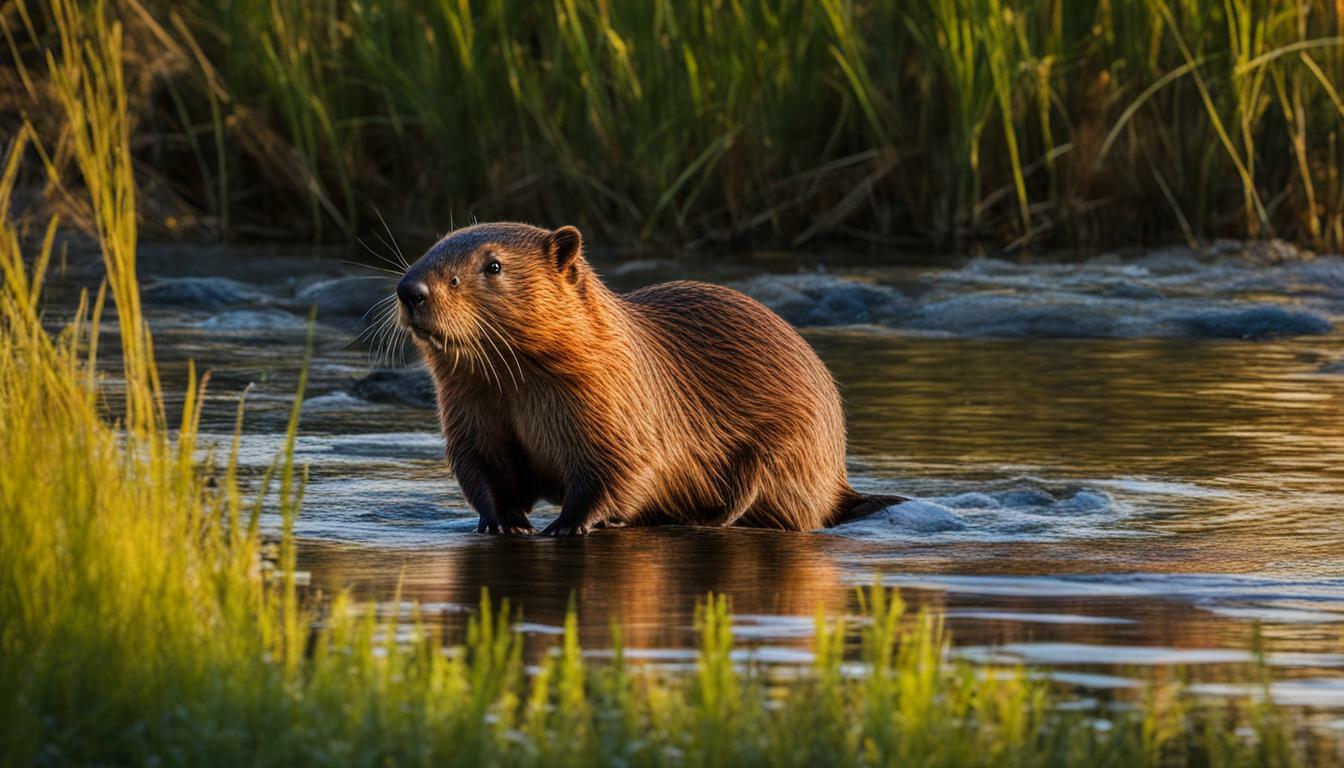Have you ever wondered if beavers eat fish? Let’s explore the eating habits of these fascinating creatures and find out!
Key Takeaways:
- Beavers are strict vegetarians and do not eat fish.
- They prefer a diet of soft vegetation like grass, aquatic plants, and leaves.
- In winter, beavers switch to tree bark as their primary food source.
- Beaver dams provide safe havens and nurseries for native fish, increasing habitat diversity.
- Native fish species can navigate over beaver dams and benefit from the calm waters and abundant nutrients.
Understanding the Beaver Diet
Before we uncover whether beavers eat fish, it’s important to understand what these creatures usually consume. Beavers are strict vegetarians, with their diets primarily consisting of soft vegetation in the summer and tree bark in the winter.
During the summer months, beavers feast on a variety of plant-based foods, including grass, aquatic plants, and leaves. These provide them with the necessary nutrients and energy to thrive. As the seasons change and winter arrives, the availability of fresh vegetation decreases, leading beavers to rely on the inner bark of trees as their primary food source.
Beavers’ ability to adapt their diet throughout the year is essential for their survival. Their strong jaws and sharp teeth allow them to gnaw through woody vegetation and access the bark beneath. This ability to consume tree bark not only provides the necessary sustenance but also plays a vital role in shaping their environment by creating dams and lodges.
| Season | Beaver Diet |
|---|---|
| Summer | Grass, aquatic plants, leaves |
| Winter | Tree bark |
Role of the Beaver Diet
The beaver’s unique diet serves an important function in its ecosystem. By consuming vegetation, beavers contribute to the natural balance of their environment. They help manage the growth of plant life in water bodies, preventing excessive overgrowth that could impede water flow and fish habitats. Additionally, the remnants of their diet, such as partially eaten trees and discarded branches, provide valuable resources for other organisms in the ecosystem.
Understanding the beaver diet is crucial when considering their interaction with fish populations. While beavers may not eat fish, their feeding habits and habitat creation through dam-building have significant implications for aquatic ecosystems.
Next, we will address the common misconception surrounding beavers and fish. Does the presence of beavers negatively impact fish populations? Let’s find out.
Beavers as Vegetarians
Contrary to popular belief, beavers are strict vegetarians and don’t include fish in their diet. They have a distinct preference for a plant-based diet, consuming a variety of soft vegetation in the summer months and switching to tree bark during the winter. Grass, aquatic plants, and leaves are the primary food sources for these industrious creatures.
Beavers are well-equipped to harvest and consume vegetation. Their large incisor teeth allow them to chew through tough plant material, while their powerful jaws can efficiently process and digest the fiber-rich plant matter. These adaptations make beavers highly efficient herbivores.
Beaver Diet: A Seasonal Shift
Their diet undergoes a seasonal shift to accommodate the changing availability of food. In the summer, when soft vegetation is abundant, beavers rely heavily on grasses and aquatic plants. These provide the necessary nutrients for their active lifestyle, as they build dams and lodges.
During the winter, when the ground is covered in snow and vegetation becomes scarce, beavers turn to tree bark as their main food source. Their sharp incisor teeth help them strip the bark off trees, providing a vital source of sustenance during these colder months.
Table: Beaver Diet
| Season | Primary Food Sources |
|---|---|
| Summer | Grasses, Aquatic Plants, Leaves |
| Winter | Tree Bark |
Do Beavers Hunt Fish?
Although beavers are skilled builders, their diet primarily consists of plant material, and they do not actively hunt fish. These industrious creatures are strict vegetarians, preferring a diet that includes soft vegetation such as grass, aquatic plants, and leaves. In winter, when their preferred food sources are scarce, beavers will switch to consuming tree bark to sustain themselves.
Beaver dams, while impressive structures, do not negatively impact fish populations. In fact, they play a crucial role in supporting the ecosystem. Beaver dams create safe havens and nurseries for native fish, contributing to increased habitat diversity. Native fish species have the ability to navigate over beaver dams, making use of the calm waters and abundant nutrients provided by these structures.
Non-native fish species may encounter more challenges in navigating beaver dams. The complex design and height of the dams may pose obstacles for these fish. However, it is important to note that the overall impact of beaver dams on fish populations is positive. They contribute to the overall health and diversity of aquatic ecosystems.
| Key Takeaways |
|---|
| Beavers are strict vegetarians and do not actively hunt fish. |
| Beaver dams provide safe havens and nurseries for native fish, increasing habitat diversity. |
| Native fish species can navigate over beaver dams and utilize the calm waters and abundant nutrients. |
| Non-native fish species may face challenges in navigating beaver dams but overall, beaver dams have a positive impact on fish populations. |
Beaver Dams and Fish Populations
Beaver dams not only serve as impressive engineering feats but also have a positive impact on fish populations in the wild. These structures, carefully crafted by beavers using trees and natural materials, create expansive ponds that provide a variety of benefits for aquatic life.
Native fish species, such as trout and salmon, can navigate over beaver dams, allowing them to access new areas of the water system. The calm waters created by the dams provide a refuge for fish, shielding them from strong currents and predators. Additionally, the ponds formed behind the dams offer abundant nutrients, which support the growth of insects and other organisms that serve as important food sources for fish.
While native fish benefit from the presence of beaver dams, non-native fish species may encounter more challenges. These fish may struggle to navigate the dams, as they are not adapted to the specific characteristics of the structures. However, it is important to note that the overall impact of beaver dams on fish populations is positive, as the benefits for native fish far outweigh any potential difficulties faced by introduced species.
| Impact of Beaver Dams on Fish Populations |
|---|
| Provide safe havens and nurseries for native fish |
| Increase habitat diversity |
| Create calm waters, shielding fish from strong currents and predators |
| Offer abundant nutrients, supporting the growth of important food sources |
In summary, beaver dams play a crucial role in supporting fish populations in the wild. They provide safe spaces, increase habitat diversity, and contribute to the overall health and abundance of native fish species. While non-native fish species may face some challenges in navigating these structures, the positive impact of beaver dams on fish far outweighs any potential difficulties. So, the next time you come across a beaver dam, appreciate the incredible work of these industrious creatures and the positive influence they have on the aquatic ecosystem.
Native Fish and Beaver Dams
Native fish species have adapted to coexist with beaver dams, utilizing the benefits they offer for their survival. These dams create calm waters that serve as safe havens and nurseries for native fish. The slow-moving water behind the dam allows fish to rest and conserve energy, while also providing protection from predators. Additionally, the abundant nutrients in the water, resulting from decaying vegetation trapped by the dams, support the growth of aquatic plants and algae that serve as a food source for the fish.
One key advantage for native fish is their ability to navigate over beaver dams. Thanks to their physical adaptations, such as streamlined bodies and flexible spines, these fish can easily swim up and over the dams. This enables them to access new habitats, including the shallow areas created by the dam, where they can find food and suitable conditions for spawning. By utilizing the calm waters and abundant resources found near beaver dams, native fish species are able to thrive and reproduce.
While native fish have adapted to coexist with beaver dams, non-native fish species may encounter more challenges. These fish may not have the physical adaptations necessary to navigate over the dams, making it more difficult for them to access the benefits provided by the dammed areas. As a result, non-native fish species may face reduced opportunities for feeding and reproduction in areas where beaver dams are present.
| Native Fish and Beaver Dams | Benefits for Native Fish | Challenges for Non-Native Fish |
|---|---|---|
| Utilization of safe havens and nurseries | Access to calm waters and abundant nutrients | Difficulty in navigating over beaver dams |
| Opportunities for rest and conservation of energy | Availability of food sources and suitable spawning conditions | Reduced opportunities for feeding and reproduction |
Overall, beaver dams have a positive impact on fish populations, particularly for native species. These dams create diverse habitats and provide essential resources for native fish to thrive. While non-native fish may face challenges, the overall benefits of beaver dams for aquatic ecosystems cannot be denied.
Challenges for Non-Native Fish
While native fish species have evolved to navigate beaver dams, non-native fish may face additional challenges in their journey. Beaver dams, with their sturdy construction and barriers, can pose difficulties for non-native fish species as they attempt to traverse these barriers. The physical structure of the dams, including the presence of branches and logs, can make it harder for non-native fish to pass through, especially if they lack the adaptations and behaviors necessary to navigate such obstacles.
Furthermore, the water flow patterns created by beaver dams can be unfamiliar to non-native fish, causing disorientation and increased energy expenditure as they try to find their way. The slower-moving water behind the dam may also provide less suitable conditions for non-native fish species, which are often more adapted to faster-flowing streams and rivers.
In addition, non-native fish may encounter competition and predation from native fish species that have adapted to the presence of the beaver dams. Native fish species have had time to establish their own strategies and behaviors for navigating the dams, giving them an advantage over non-native species.
| Challenges for Non-Native Fish | Solutions |
|---|---|
| Physical barriers created by beaver dams | Non-native fish may need to find alternative routes or use their agility to overcome these obstacles. |
| Unfamiliar water flow patterns | Non-native fish may need to adjust their navigation strategies and energy expenditure to adapt to slower-moving waters. |
| Competition and predation by native fish species | Non-native fish may need to compete for resources or develop strategies to avoid predation. |
Despite these challenges, it is important to note that beaver dams, as a natural part of aquatic ecosystems, play a vital role in supporting overall fish populations, both native and non-native. The increased habitat diversity provided by these dams benefits a wide range of species, contributing to the overall health and biodiversity of aquatic ecosystems.
The Positive Impact of Beaver Dams
Contrary to concerns, beaver dams actually have a positive impact on fish populations, fostering healthier aquatic ecosystems. These unique structures provide safe havens and nurseries for native fish, contributing to increased habitat diversity. Native fish species have the ability to navigate over beaver dams, utilizing the calm waters and abundant nutrients that they provide.
Beaver dams create a series of interconnected ponds, allowing fish to find refuge from predators and harsh environmental conditions. The slow-moving water behind these dams creates a favorable environment for fish to thrive. The ponds also serve as nurseries for young fish, providing protection from predators and access to an abundance of food sources.
Native fish species have evolved to coexist with beavers and have adapted to navigate over beaver dams. They utilize the dams as natural stepping stones, allowing them to access new habitats and resources. The calm waters created by the dams provide ideal conditions for fish to feed, rest, and reproduce.
| Benefit | Description |
|---|---|
| Increased Habitat Diversity | Beaver dams create a network of ponds and wetlands, increasing the variety of habitats available to fish species. |
| Protection and Refuge | The dams provide safe spaces for fish to hide from predators and find shelter during extreme weather events. |
| Nutrient Enrichment | The slow-moving water behind beaver dams accumulates organic matter, providing a rich source of nutrients for fish and other aquatic organisms. |
While non-native fish species may face additional challenges in navigating beaver dams, the overall impact of these dams on fish populations is positive. Beaver dams contribute to the health and vitality of aquatic ecosystems, supporting native fish populations and promoting biodiversity.
Conclusion
In conclusion, beavers are fascinating creatures with a strictly vegetarian diet, and their dams play a crucial role in supporting fish populations. Beavers are known to prefer soft vegetation like grass, aquatic plants, and leaves during the summer months, while switching to tree bark in the winter. They do not actively hunt fish or consume them as part of their diet.
While beavers are renowned for building dams, these structures do not have a negative impact on fish populations. In fact, beaver dams provide important benefits for native fish species. They create safe havens and nurseries, increasing habitat diversity and supporting the growth of fish populations.
Native fish species have the ability to navigate over beaver dams, taking advantage of the calm waters and abundant nutrients found within. This allows them to thrive in these unique ecosystems. However, non-native fish species may face more challenges in navigating the dams, potentially impacting their distribution and abundance.
Overall, beaver dams have a positive impact on fish populations. They contribute to the health and biodiversity of aquatic ecosystems, ensuring the survival and prosperity of native fish species. With their vegetarian diet and important role as ecosystem engineers, beavers continue to be a vital part of our natural world.
FAQ
Do beavers eat fish?
No, beavers do not eat fish. They are strict vegetarians and prefer a diet of soft vegetation in summer, such as grass, aquatic plants, and leaves. They switch to tree bark in winter.
Do beavers actively hunt fish?
No, beavers do not actively hunt fish. They focus on consuming vegetation and do not prey on fish.
Do beaver dams negatively impact fish populations?
No, beaver dams do not negatively impact fish populations. In fact, they provide safe havens and nurseries for native fish, increasing habitat diversity. Native fish species can navigate over beaver dams and utilize the calm waters and abundant nutrients. Non-native fish species may face more challenges in navigating the dams.
What is the positive impact of beaver dams on fish populations?
Beaver dams have a positive impact on fish populations. They provide safe havens and nurseries for native fish, increasing habitat diversity. Native fish species can navigate over beaver dams and utilize the calm waters and abundant nutrients. This contributes to the overall health and diversity of aquatic ecosystems.
Do beaver dams benefit native fish species?
Yes, beaver dams benefit native fish species. Native fish can navigate over beaver dams and benefit from the calm waters and abundant nutrients they provide. The dams serve as safe havens and nurseries, creating more favorable conditions for native fish.
Do non-native fish face challenges in navigating beaver dams?
Yes, non-native fish species may face more challenges in navigating beaver dams compared to native fish. The dams are primarily designed by beavers for their own habitat needs, and non-native fish may encounter difficulties in navigating the structures.
How do beaver dams contribute to increased habitat diversity?
Beaver dams contribute to increased habitat diversity by creating new waterways and wetland environments. These structures provide different microhabitats where various species can thrive, promoting biodiversity within aquatic ecosystems.
What is the diet of beavers?
Beavers have a primarily vegetarian diet. They consume soft vegetation in summer, such as grass, aquatic plants, and leaves. In winter, they switch to feeding on tree bark.
Do beavers have a positive impact on fish populations?
Yes, beavers have a positive impact on fish populations. The dams they build provide safe havens and nurseries for native fish, increasing habitat diversity and contributing to the overall health of aquatic ecosystems.




